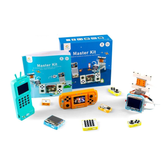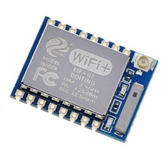-
Witty Cloud ESP12F ModuleWitty Cloud ESP12F ESP8266 Serial WiFi Development Board (Mini Node MCU Module) The ESP8266/ ESP-12F Module/ Serial WIFI Witty Cloud Development Board + MINI nodeMCU is a cheap and small Wifi transceiver, a perfect solution for Home Automation and IoT applications. It can be the replacement for...
- Rs. 248
Rs. 349- Rs. 248
- Unit price
- per
Save Rs. 101 -
ESP8285 Wi-Fi SoC ModuleESP8285 Wi-Fi SoC Module The ESP8285 has a unique design that allows flexibility while docking into existing products. It uses a DIP plug in a package that makes it suitable for automation, large-scale, modern production of low-cost, convenient applications in various networking hardware terminal...
- Rs. 292
Rs. 399- Rs. 292
- Unit price
- per
Save Rs. 107 -
WiFi Kit 32WiFi Kit 32 WiFi Kit 32 is a classic IoT dev-board designed & produced by Heltec Automation(TM), it’s a highly integrated product based on ESP32 (include Wi-Fi and BLE), Li-Po battery management system, 0.96? OLED is also included. It’s the best choice for smart...
- Rs. 1,416
Rs. 1,980- Rs. 1,416
- Unit price
- per
Save Rs. 564 -
ESP8266 Serial WIFI Wireless Transceiver Module ESP-07 Send Receive LWIP AP Plus STAESP8266 Serial WIFI Wireless Transceiver Module ESP-07 Send Receive LWIP AP Plus STA The ESP-07 WiFi module is developed by AI-Thinker Co., Ltd, has an ultra-low power 32-bit MCU micro, with a 16-bit short mode, clock speed support 80 MHz, 160 MHz, supports the RTOS,...
- Rs. 230
Rs. 263- Rs. 230
- Unit price
- per
Save Rs. 33 -
ESP32 CP2102 Wireless Development Board D1 LOLIN32ESP32 CP2102 Wireless Development Board D1 LOLIN32 The D1 LOLIN32 ESP32 CP2102 Wireless Development Board is a small yet powerful device that improves the adaptability and effectiveness of your Internet of Things projects. Based on the reliable ESP-32 chip, this board has 4MB of...
- Rs. 449
Rs. 599- Rs. 449
- Unit price
- per
Save Rs. 150 -
ESP8266 Wroom Downloader Burning Fixture Tool Programming BoardESP8266 Wroom Burning Fixture Tool Downloader The ESP8266 development fixture board can be used to program ESP8266 chips for development and small-batch production. The development board comprises fixtures for the ESP32 modules with an inbuilt CP2104 USB-TTL chip and an AMS1117 3.3 version regulator...
- Rs. 599
Rs. 699- Rs. 599
- Unit price
- per
Save Rs. 100 -
ESP32 MH-ET Live ModuleESP32 MH-ET Live Module The ESP32 is already an integrated antenna and RF balun, power amplifier, low-noise amplifiers, filters, and power management module. The entire solution takes up the least amount of printed circuit board area. This ESP board is used with 2.4 GHz dual-mode...
- Rs. 760
Rs. 919- Rs. 760
- Unit price
- per
Save Rs. 159 -
Lolin Node MCU baseLolin Node MCU base The NodeMcu Lua WIFI Development Board ESP8266 Serial Port Baseboard is a networking platform that is open source. It is programmed in the Lua scripting language. This baseboard is the Breakout Board for our NodeMcu ESP8266 V3 Lua CH340 Wifi Dev. Allows...
- Rs. 106
Rs. 149- Rs. 106
- Unit price
- per
Save Rs. 43 -
Beetle ESP32 - C3 (RISC-V Core Development Board)Beetle ESP32 - C3 (RISC-V Core Development Board) Beetle ESP32-C3, a compact IoT solution ideal for wearables, sports projects, and more. With mini size, safety features, dual-mode communication, and comprehensive tutorials, this controller ensures seamless integration into diverse applications. Made for IoT enthusiasts, it...
- Rs. 769
Rs. 1,499- Rs. 769
- Unit price
- per
Save Rs. 730 -
Airgain N2420 2.4 Ghz 4DB WiFi Omnidirectional Antenna - IPEX-IPX (Set of 2)Airgain N2420 2.4 Ghz 4DB WiFi Omnidirectional Antenna 2.4GHz built-in PCB antenna N2420, is our company's well-designed dipole PCB antenna, the gain is up to 3.5dBi (+/-0.5), the effect is comparable to the external rod-shaped omnidirectional antenna. The wire uses a low-loss high-frequency coaxial...
- Rs. 79
Rs. 109- Rs. 79
- Unit price
- per
Save Rs. 30 -
ESP32-C6-WROOM-1-N8 Development Board with HeadersESP32-C6-WROOM-1-N8 Development Board with Headers The ESP32-C6-WROOM-1-N8 Development Board is a high-performance, general-purpose module designed for Wi-Fi, IEEE 802.15.4, and Bluetooth LE applications. Operating in the 2.4 GHz frequency band, it features a 1T1R configuration for efficient wireless communication. The module includes 4MB SPI...
- Rs. 1,047
Rs. 1,999- Rs. 1,047
- Unit price
- per
Save Rs. 952 -
V3 Version 863MHz-928MHz SX1262 ESP32 WIFI bluetooth Lora with 0.96 OLED DisplayV3 Version 863MHz-928MHz SX1262 ESP32 WIFI Bluetooth Lora with 0.96 OLED Display The ESP32 LoRa SX1262 0.96 Inch OLED Display Bluetooth WiFi Module for Arduino is a new development of the cost-effective networking program. The ESP 32 WiFi LoRa is a classic IoT dev-board...
- Rs. 1,899
Rs. 2,499- Rs. 1,899
- Unit price
- per
Save Rs. 600 -
ESP32 CAM WiFi Module with OV3660 Camera Module 2MPESP32 CAM WiFi Module with OV3660 Camera Module 2MP The ESP32 development board with Cam WiFi Module is a great choice for IoT fans in India. It features a high-quality 2MP OV3660 camera. The built-in OV3660 camera produces high-quality images, which makes it ideal...
- Rs. 629
Rs. 744- Rs. 629
- Unit price
- per
Save Rs. 115 -
ESP32 LoRa with Display - 863MHz-928MHz SX1276ESP32 LoRa with Display ESP32 LoRa with Display - 863MHz-928MHz SX1276 is a development board for IoT projects that includes an ESP32 microprocessor, a SX1276 LoRa node chip, and a 0.96-inch OLED display.ESP32 LoRa with Display operates on frequencies between 863MHz and 928MHz and...
- Rs. 1,849
Rs. 2,683- Rs. 1,849
- Unit price
- per
Save Rs. 834 -
Ai Thinker ESP-01F ESP8285 Serial WiFi ModuleAi Thinker ESP-01F ESP8285 Serial WiFi Module Ai Thinker ESP-01F ESP8285 Serial WiFi Module has a highly competitive package size and ultra-low technology. ESP-01F can be widely used in a variety of networking, for home automation, industrial wireless control, baby monitors, wearable electronic products,...
- Rs. 178
Rs. 270- Rs. 178
- Unit price
- per
Save Rs. 92 -
WeMos Lolin V1.0 wifi+BluetoothWeMos Lolin V1.0 wifi+Bluetooth This is WeMos LOLIN32 board which is based on ESP 32 Rev1 Wifi and Bluetooth Board. The WeMosboard is designed perfectly for DIY wifi-based projects compatible with Arduino. This WeMos Lolin wifi board is inspired by Adafruit’s Feather series. It has 4 MB flash memory...
- Rs. 514
Rs. 820- Rs. 514
- Unit price
- per
Save Rs. 306 -
ESP8266 12FESP8266 12F ESP8266 is high integration wireless SOCs, designed for space and power-constrained mobile platform designers. It provides unsurpassed ability to embed Wi-Fi capabilities within other systems or to function as a standalone application, with the lowest cost, and minimal space requirement. It is...
- Rs. 139
Rs. 148- Rs. 139
- Unit price
- per
Save Rs. 9 -
ESP32 Node MCU Development Board with Wifi and Bluetooth (CP2102 Driver, 30 PIN)ESP32 (CP2102 Driver, 30 Pin) WiFi + Bluetooth NodeMCU-32 Development Board) Looking to supercharge your IoT projects? The ESP32 Node MCU Development Board with Wi-Fi and Bluetooth (CP2102) is your go-to solution. And the best part? You can buy it now at an unbeatable...
- Rs. 348
Rs. 497- Rs. 348
- Unit price
- per
Save Rs. 149 -
Node MCU ESP8266 V3 (LOLIN CH340 chip)Node MCU ESP8266 V3 (LOLIN CH340 chip) The Lolin NodeMCU ESP8266 V3 WiFi Module is your key to unlocking the potential of the Internet of Things (IoT). If you're searching for a seamless and affordable IoT development solution in India, you've found it. This...
- Rs. 179
Rs. 224- Rs. 179
- Unit price
- per
Save Rs. 45 -
ESP-12 D1 Mini V2 BoardESP-12 D1 Mini V2 Board This is a D1 Mini V2 NodeMcu 4M Bytes Lua WIFI Internet Of Things Development Board Based ESP8266, it is a mini WIFI board based on ESP-8266EX. 11 digital input/output pins, and all pins have interrupt/PWM/I2C/one-wire supported (except D0)...
- Rs. 146
Rs. 199- Rs. 146
- Unit price
- per
Save Rs. 53

Best Price Guarantee

Ready Stock for Bulk Purchase

Dedicated Account Managers

5% GST Benefits for Eligible SEZ and Edu

Technical Support Available

1-Year Manufacturer Warranty





















































